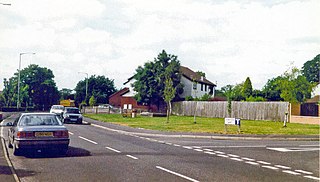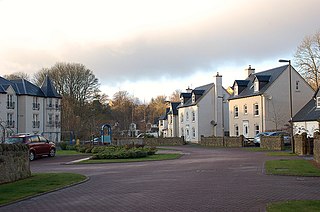The Shropshire and Montgomeryshire Light Railway was a railway running from Shrewsbury, England to Llanymynech, Wales, with a branch to Criggion. It was promoted by Holman Fred Stephens, better known as Colonel Stephens, proprietor of several ultra-low budget light railways. It adopted the track network of the defunct Potteries, Shrewsbury and North Wales Railway that had closed in 1880; the S&MLR opened in 1911. Running through sparsely inhabited terrain, it struggled to achieve financial stability, and following a serious deterioration of maintenance conditions, it closed to passengers in 1933, continuing with a basic goods and mineral service.

Newtonmore railway station serves the village of Newtonmore, Highland, Scotland. The station is managed by ScotRail and is on the Highland Main Line. The station is 68 miles 62 chains (110.7 km) from Perth, between Dalwhinnie and Kingussie, and has a single platform which is long enough for a ten-coach train. It is currently the only station on the Highland Main Line to have one platform, although the former second platform can still be seen adjacent to the first platform.

Garstang Town railway station served the market town of Garstang in Lancashire, England. It opened in 1870. The station closed for passengers in 1930 and for freight in 1965.

Auchterless railway station was a railway station in Auchterless, Aberdeenshire. It served the rural area, the estate of Towie Barclay and a settlement known as Kirkton of Auchterless stands 3 miles (5 km) away. It was opened in 1857 by the Banff Macduff & Turriff Junction Railway, later part of the Great North of Scotland Railway, then the LNER and finally British Railways, on the branchline from Inveramsay to Macduff, the station closed to passengers in 1951 and to goods in 1966. The station lay below Gallowhill and the town lay to the north-east.
Penton railway station served the parish of Penton from 1862 to 1969 on the Border Union Railway.

The Bourne and Sleaford Railway was promoted as a branch of the Great Northern Railway to fend off an expected incursion by the rival Great Eastern Railway. It was authorised by Parliament in 1865, but not opened until 1871 and 1872. Although agricultural traffic provided healthy business, the rural character of the line never produced much passenger trade, and it was closed to passengers in 1930. The line was severed and ceased to be a through line in 1956 and closed completely in 1965.
The Macmerry Branch was a North British Railway built double track branch railway line in East Lothian, Scotland, that ran from a junction west of Inveresk on the East Coast Main Line to Macmerry via four intermediate stations, Smeaton, Crossgatehall Halt, Ormiston, and Winton. Two lines ran off the branch line, one a spur line to Hardengreen Junction on the Waverley Line from Smeaton, and the other a branch line to Gifford from just past Ormiston.

The Banff, Macduff and Turriff Junction Railway was a railway company that connected the Aberdeenshire town of Turriff with the main line of the Great North of Scotland Railway (GNoSR) at Inveramsay. It had earlier been intended to reach Macduff, but shortage of finance forced curtailment. It opened its line in 1857.
The Smeaton railway branches of the Lothians were a group of railway branches in East Lothian and Midlothian, Scotland, in the area between Dalkeith and Haddington.

Croxdale railway station served the village of Croxdale, County Durham, England from 1872 to 1938 on the East Coast Main Line.
Newbiggin-by-the-Sea railway station, also referred to as Newbiggin station, served the town of Newbiggin-by-the-Sea, Northumberland, England from 1872 to 1964 on the Blyth and Tyne Railway.

Rosslynlee railway station served the village of Roslin, Midlothian, Scotland from 1855 to 1962 on the Peebles Railway.
Pomathorn Halt railway station served the town of Penicuik, Midlothian, Scotland from 1855 to 1962 on the Peebles Railway.

Leadburn railway station served the hamlet of Leadburn, Midlothian, Scotland from 1855 to 1962 on the Peebles Railway.

Penicuik railway station served the town of Penicuik, Midlothian, Scotland from 1872 to 1951 on the Penicuik Railway.

Little Somerford railway station served the village of Little Somerford, Wiltshire, England from 1903 to 1963. It was on the South Wales Main Line and served as the junction for the Malmesbury branch line from 1933.

Kirkbank railway station served Old Ormiston, in the Scottish Borders, Scotland from 1856 to 1948 on the Jedburgh Railway.
Macbie Hill railway station served the hamlet of Coalyburn, Peeblesshire, Scotland, from 1864 to 1933 on the Leadburn, Linton and Dolphinton Railway.

Winton railway station served the village of New Winton, East Lothian, Scotland, from 1872 to 1925 on the Macmerry Branch.
Loanhead railway station served the town of Loanhead, Midlothian, Scotland, from 1874 to 1968 on the Edinburgh, Loanhead and Roslin Railway.












